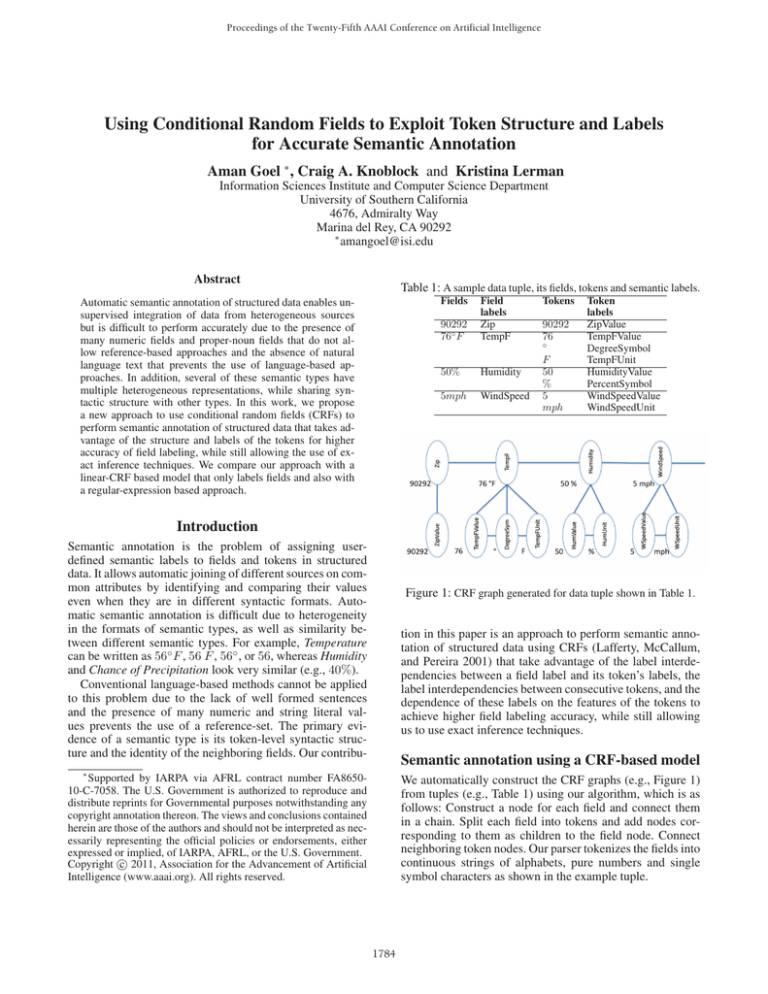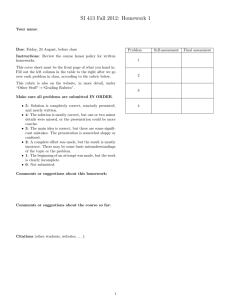
Proceedings of the Twenty-Fifth AAAI Conference on Artificial Intelligence
Using Conditional Random Fields to Exploit Token Structure and Labels
for Accurate Semantic Annotation
Aman Goel ∗ , Craig A. Knoblock and Kristina Lerman
Information Sciences Institute and Computer Science Department
University of Southern California
4676, Admiralty Way
Marina del Rey, CA 90292
∗
amangoel@isi.edu
Abstract
Table 1: A sample data tuple, its fields, tokens and semantic labels.
Fields
Automatic semantic annotation of structured data enables unsupervised integration of data from heterogeneous sources
but is difficult to perform accurately due to the presence of
many numeric fields and proper-noun fields that do not allow reference-based approaches and the absence of natural
language text that prevents the use of language-based approaches. In addition, several of these semantic types have
multiple heterogeneous representations, while sharing syntactic structure with other types. In this work, we propose
a new approach to use conditional random fields (CRFs) to
perform semantic annotation of structured data that takes advantage of the structure and labels of the tokens for higher
accuracy of field labeling, while still allowing the use of exact inference techniques. We compare our approach with a
linear-CRF based model that only labels fields and also with
a regular-expression based approach.
90292
76◦ F
Field
labels
Zip
TempF
50%
Humidity
5mph
WindSpeed
Tokens
90292
76
◦
F
50
%
5
mph
Token
labels
ZipValue
TempFValue
DegreeSymbol
TempFUnit
HumidityValue
PercentSymbol
WindSpeedValue
WindSpeedUnit
Introduction
Semantic annotation is the problem of assigning userdefined semantic labels to fields and tokens in structured
data. It allows automatic joining of different sources on common attributes by identifying and comparing their values
even when they are in different syntactic formats. Automatic semantic annotation is difficult due to heterogeneity
in the formats of semantic types, as well as similarity between different semantic types. For example, Temperature
can be written as 56◦ F , 56 F , 56◦ , or 56, whereas Humidity
and Chance of Precipitation look very similar (e.g., 40%).
Conventional language-based methods cannot be applied
to this problem due to the lack of well formed sentences
and the presence of many numeric and string literal values prevents the use of a reference-set. The primary evidence of a semantic type is its token-level syntactic structure and the identity of the neighboring fields. Our contribu-
Figure 1: CRF graph generated for data tuple shown in Table 1.
tion in this paper is an approach to perform semantic annotation of structured data using CRFs (Lafferty, McCallum,
and Pereira 2001) that take advantage of the label interdependencies between a field label and its token’s labels, the
label interdependencies between consecutive tokens, and the
dependence of these labels on the features of the tokens to
achieve higher field labeling accuracy, while still allowing
us to use exact inference techniques.
Semantic annotation using a CRF-based model
∗
Supported by IARPA via AFRL contract number FA865010-C-7058. The U.S. Government is authorized to reproduce and
distribute reprints for Governmental purposes notwithstanding any
copyright annotation thereon. The views and conclusions contained
herein are those of the authors and should not be interpreted as necessarily representing the official policies or endorsements, either
expressed or implied, of IARPA, AFRL, or the U.S. Government.
c 2011, Association for the Advancement of Artificial
Copyright Intelligence (www.aaai.org). All rights reserved.
We automatically construct the CRF graphs (e.g., Figure 1)
from tuples (e.g., Table 1) using our algorithm, which is as
follows: Construct a node for each field and connect them
in a chain. Split each field into tokens and add nodes corresponding to them as children to the field node. Connect
neighboring token nodes. Our parser tokenizes the fields into
continuous strings of alphabets, pure numbers and single
symbol characters as shown in the example tuple.
1784
Table 2: Performance of our approach on 12 websites.
Domain
(field types,
token types)
Weather
forecast
(15, 36)
Figure 2: Junction tree constructed from CRF graph in Figure 1.
Flight
status
(8, 17)
We then attach some of the following syntactic features to
each token: capitalization, length of token, starting character
or digit, number of digits after decimal, digit at units place,
sign of the number, and identity of the token itself.
We use seven types of feature functions to capture the relationships between the following: (1) the label and feature
on a token node, (2) the label of a token node and feature of
its previous token, (3) the label of a token node and feature
of its next token, (4) the label of a field node and presence of
a feature on any of its tokens, (5) the labels of two adjacent
token nodes and their features, (6) the labels of a field and
its token node and features of the token, and (7) the labels of
two adjacent field nodes and presence of a feature each on
any of their respective tokens. We use binary feature functions, that return either zero or one. For example, a feature
function of the third type defined above can take as inputs the
label of a token node and the feature list of next token and
return the value one only if the first node is labeled HouseNumber and the next token has the feature Capitalized.
Training of a model and labeling of a new tuple, both involve performing inference on the CRFs. Since our CRFs
have loops, we use the junction tree algorithm (Lauritzen
and Spiegelhalter 1988) to convert our CRF graphs into
acyclic junction trees (JT) (Figure 2). Each node in the JT
represents a clique in the CRF graph. Figure 2 shows the JT
for the CRF graph shown in Figure 1. It is the property of
our CRF graph structure that it leads to a linear chain JT,
which makes using belief propagation (BP) (Pearl 1988) on
it very easy. Since BP calculates the beliefs for all possible
label assignments and one node of JT represents a clique in
the CRF, the maximum number of label assignments to a JT
node is exponential in the size of the largest clique, which is
three in our CRFs. This keeps the complexity low and avoids
the need for approximate inference methods.
Geocoding
(5,12)
Website
URL
wunderground.com
weather.unisys.com
weather.com
noaa.gov
average
flytecomm.com
flightview.com
delta.com
continental.com
average
geocoder.us
geocoder.ca
geonames.com
worldkit.com
average
Field
labeling
accuracy
0.89
0.43
0.70
1.00
0.75
0.89
0.96
0.81
0.96
0.90
1.00
1.00
0.98
1.00
0.99
Token
labeling
accuracy
0.92
0.75
0.79
0.86
0.83
0.82
0.97
0.78
0.55
0.79
0.85
0.82
0.68
0.89
0.81
Related Work
Zhu et al. (2005) used two-dimensional CRFs and (Tang et
al. 2006) used tree-structured CRFs to exploit spatial relationships between elements on webpages and documents,
respectively. Our hierarchical-CRF exploits the semantic relationship between field and token labels in data tuples.
Schema matching techniques (Doan, Domingos, and
Levy 2000) can be used to perform semantic annotation by
column-wise matching between labeled and unlabeled relational tables. These techniques assume that there are a large
number of rows in each table. Although we train our model
on multiple tuples, we only label one tuple at a time. This
allows us to label variable length tuples.
Conclusion
In this paper, we presented a CRF-based approach to exploit
the token-level structure of the fields to perform accurate semantic annotation of structured data. We showed that this
approach achieves about 13% higher accuracy than a linearCRF model that assigns labels to fields only.
References
Doan, A.; Domingos, P.; and Levy, A. Y. 2000. Learning source
descriptions for data integration. WebDB 81-86.
Lafferty, J.; McCallum, A.; and Pereira, F. 2001. Conditional random fields: Probabilistic models for segmenting and labeling sequence data. In Proceedings of the ICML, 282–289.
Lauritzen, S. L., and Spiegelhalter, D. J. 1988. Local computations
with probabilities on graphical structures and their application to
expert systems. Journal of the Royal Statistical Society 50(2).
Pearl, J. 1988. Probabilistic Reasoning in Intelligent Systems. Morgan Kaufmann, 2nd edition.
Tang, J.; Hong, M.; Li, J.; and Liang, B. 2006. Tree-structured
conditional random fields for semantic annotation. In ISWC.
Viterbi, A. J. 1967. Error bounds for convolutional codes and an
asymptotically optimum decoding algorithm. IEEE Transactions.
Zhu, J.; Nie, Z.; Wen, J.; Zhang, B.; and Ma, W. 2005. 2d conditional random fields for web information extraction. In 22nd ICML.
Experiments
We collected data by extracting 15 tuples each from four
websites in three domains. In each domain, we ran four experiments, each time training on data from three websites
and testing on the fourth website. The details of the domains
and the results are reported in Table 2. Field labeling accuracy is more than 80% for 10 out of the 12 websites and
token labeling accuracy is around 80% for all the three domains. The average accuracy across all domains is 88%. We
compared our performance with a regular-expression-based
approach and a linear-CRF-based approach, where the fields
are not split into tokens and found their accuracy to be 75%
and 48%, respectively.
1785








